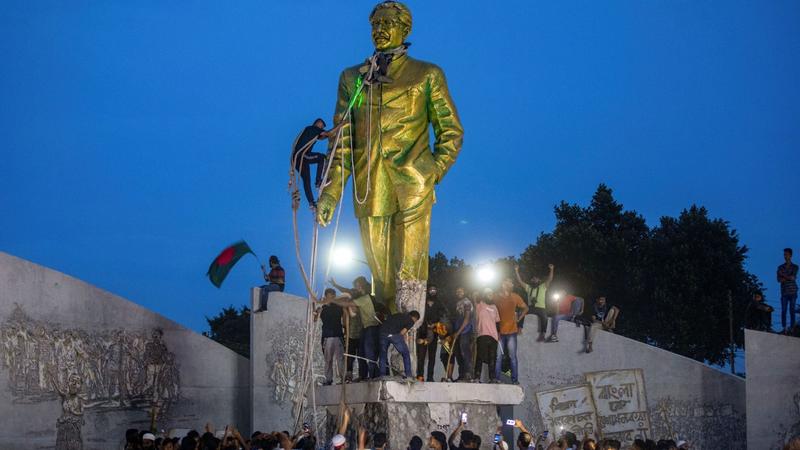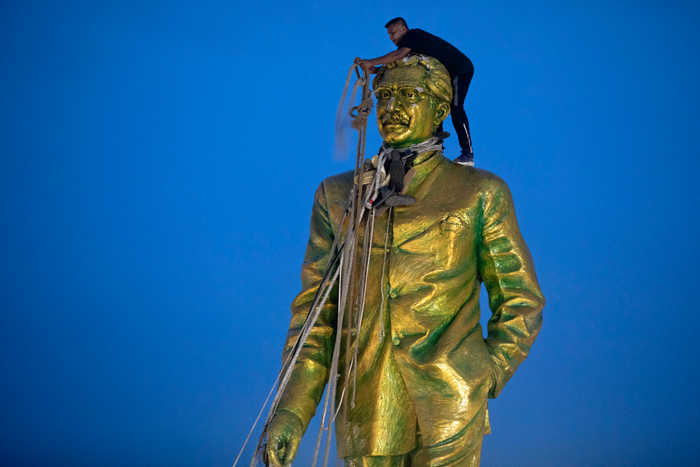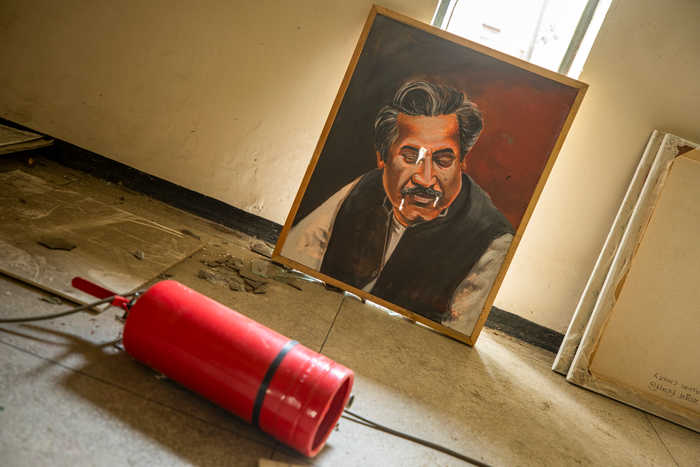Published 10:37 IST, August 6th 2024
Video: Moment When Protesters Toppled Sheikh Mujibur Rahman's Statue Amid Bangladesh Unrest
After looting Sheikh Hasina's official residence and storming the Parliament, agitators were seen bringing down the statue of Sheikh Mujibur Rahman.

Dhaka: After weeks of mass protests in Bangladesh, Monday marked the deadliest day in years, with nearly 100 people killed. In the wake of this violence, longtime Bangladeshi leader Sheikh Hasina resigned as Prime Minister and fled the country. Following a stopover in India, she is expected to move to London to live out her remaining days in self-exile, effectively ending her political career.
Hours after Hasina's resignation, demonstrators in Dhaka escalated their anti-government protests by vandalising and toppling a statue of her father, 'Bangabandhu' Sheikh Mujibur Rahman, late at night. After looting Sheikh Hasina's official residence and storming the Parliament, agitators were seen bringing down the statue of Sheikh Mujibur Rahman.
Hailed as the ‘Father of the Nation’ in Bangladesh, Mujibur was the foremost leader of the country's war of liberation against Pakistan, which led to a genocidal campaign in the country until 1971. With India's assistance, pro-independence forces ultimately freed the country from Pakistani rule.
The scene of protesters toppling the statue resembled the moment in Baghdad when opponents brought down Saddam Hussein’s statue following the US-led invasion that ended his rule in Iraq.
 Bangladesh is currently facing a volatile political situation following Prime Minister Sheikh Hasina's resignation amid escalating protests. What began as peaceful student demonstrations against a quota system for government jobs evolved into a widespread uprising. The unrest ultimately forced Hasina to resign and flee the country by helicopter, ending her 15-year tenure.
Bangladesh is currently facing a volatile political situation following Prime Minister Sheikh Hasina's resignation amid escalating protests. What began as peaceful student demonstrations against a quota system for government jobs evolved into a widespread uprising. The unrest ultimately forced Hasina to resign and flee the country by helicopter, ending her 15-year tenure.
Hasina's residence Sudha Sadan and other establishments were attacked, vandalised and set on fire in the capital after her departure. The residences and business establishments of ministers, party MPs and leaders of Hasina's Awami League government were also attacked in Dhaka and outside Dhaka.
 Over the past few weeks, violent clashes led to nearly 300 deaths, according to local media reports. The government's attempts to suppress the protests through curfews, internet outages, and forceful tactics only intensified the situation, fueling further outrage and unrest.
Over the past few weeks, violent clashes led to nearly 300 deaths, according to local media reports. The government's attempts to suppress the protests through curfews, internet outages, and forceful tactics only intensified the situation, fueling further outrage and unrest.
It remains unclear whether Bangladeshi Prime Minister Sheikh Hasina will remain in Delhi or move to another location, with speculation suggesting she might head to London.
Meanwhile, in Dhaka, leaders of the Anti-Discrimination Student Movement have proposed establishing an interim government led by Nobel Laureate Dr. Muhammad Yunus to tackle the country's ongoing issues. This proposal was announced early Tuesday in a video message by key student leaders Nahid Islam, Asif Mahmud, and Abu Bakar Mazumdar.
On Monday night, President Mohammed Shahabuddin approved the creation of an interim government to manage the country. Earlier that evening, Nahid Islam had stated that a framework for the interim government would be outlined within the next 24 hours.
Updated 10:38 IST, August 6th 2024




